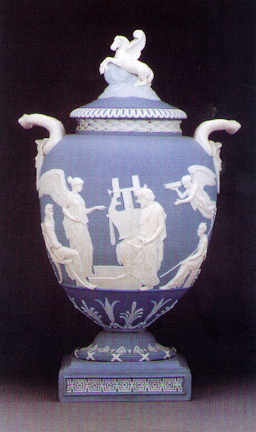
"Pegasus Vase," Porcelain 'jasper ware,' designed by John Flaxman
Wedgwood, England 1786 CE, 18.5" height
ART 198 - HISTORY OF WORLD CERAMICS
| This piece, called the 'Pegasus Vase,' exhibits the Neoclassic hallmarks of the Wedgwood style. Josiah Wedgwood teamed with the businessman Thomas Bentley in 1762 to found the 'Etruria' factory. Bentley was very interested in the art of the classic Greek and Roman world, a current 'rage' in England following the discoveries of Greek vases in Etruscan tombs, as well as the recent excavations at Herculaneum and Pompeii. In Wedgwood, Bentley found the artist with the technical and design skills to supervise a new line of porcelains based on these classical models. One of the signature lines from Wedgwood was 'jasperware,' a high-firing porcelain clay body that he colored with cobalt oxide to produce the delicate blue seen here. The figures were appliques of translucent, white porcelain that were added to the surface of the blue clay at the leatherhard stage and fired on. Blue and white jasperware was the most common and successful, but amber and white, green and white, and black and white were also used. This particular vase, the Pegasus vase, so named for the winged horse atop the lid, depicts the 'Apotheosis of Homer' on the main part of the form. An apotheosis refers to the elevation to divine rank of a human, and here Homer ascends the stairs accompanied by winged goddesses, in a composition arranged quite like what one might encounter on a classic Greek vase. Note the use of the hydria form as well. 'The Apotheosis of Homer' is also a painting by Ingres in the Louvre. | "Pegasus Vase," Porcelain 'jasper ware,' designed by John Flaxman Wedgwood, England 1786 CE, 18.5" height |
|
|